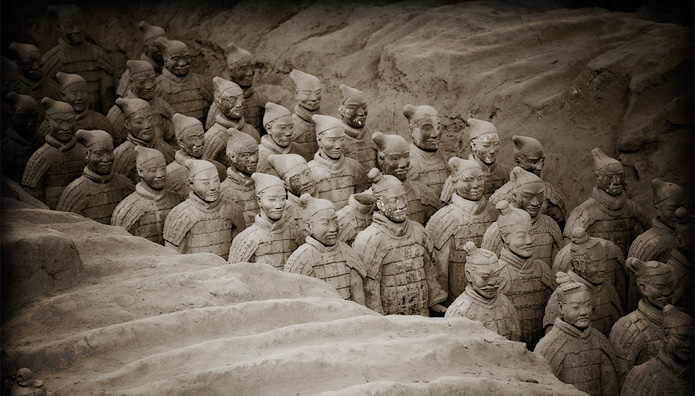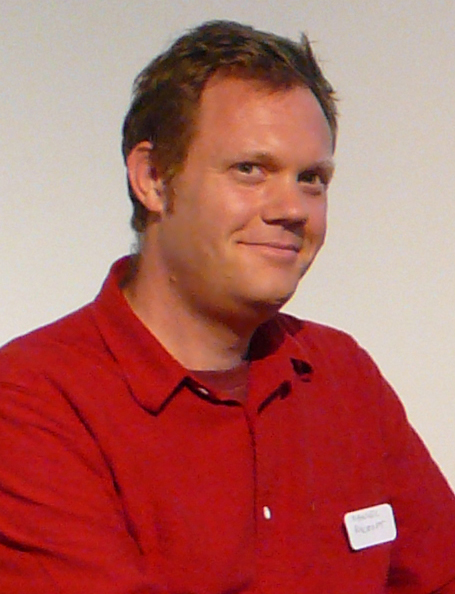 World Art and the Imperial Imagination (7 oktober 2011) Terracotta Army. Foto: Davie Gan
World Art and the Imperial Imagination (7 oktober 2011) Terracotta Army. Foto: Davie Gan Report: World Art and the Imperial Imagination
During the annual conference of the Netherlands Museum Association Framer Framed organized a workshop at Museum de Lakenhal (Leiden 2011), featuring special guest lecturer Daniel Rycroft of East Anglia University and Wim Manuhutu former director of the Museum Maluku in Utrecht. One of the main points of contention was to question how collaboration between different disciplines and types of museums can be stimulated. The suggested methodology is for institutions, both scholastic and otherwise, to re-approach the humanities’, cultural objects and projects from a more interdisciplinary, and cosmopolitan outlook. This new perspective is the World Art Movement.
The idea of shifting to a World Art perspective is problematic for the the art history and related humanities fields. The inception of the theoretical publication ‘World Art’ seeks to re-interpret the way in which we develop, represent, research and articulate nonwestern art within our western community. In addition to the new publication, the development of world art as a more contemporary art historical discipline seeks to act as a means of unraveling related histories. This newer perspective helps to articulate global positions, reflecting and re-evaluating the conditionality of exhibitions and institutions.
Rycroft attempts to define world art as a shifting matrix of intercultural exchanges and encounters, which highlights globally relevant transformations. It is a concept that pertains as much to contexts of making and interpretation as to material objects, artworks and other forms of visual and performative creativity. It will contribute to the re-construction of canonical values, and the re-consideration of numerous pressing concerns. Additionally, it encourages cosmopolitan engagement and interaction through the research, development and implementation of different disciplines. Through utilizing these tools and resources, academics are able to amass critical vocabulary to engage different cultures, which may change the dynamics of how we look at the critical canon.
The publication is the first issue of World Art, a brand new space dedicated to the works and debates about human creativity, broadly envisaged. Vertically, the examination of histories of art has been paired with anthropology and archaeology. However and more recently, the trend in these studies has been more lateral. Rather than looking at material objects and art projects in a historical or chronological order, World Art looks at comparative developments, things, environments, places, and the organizations, formations, and understandings of cultures. For these reasons, this World Art approach better compliments other endeavors such as research and education.
The first issue features articles includes contributed articles from diverse humanities faculties across the globe. Topics are broad, touching upon such concepts as “World Art History with Modern and Contemporary Asian Art” and “Minimalism and Maximalism”. The new journal as well as this newly developed methodological approach seeks to posit itself amongst dialogues with post-colonial studies and related epistemology. Ultimately, the desired result is to develop new research areas in order to better stabilise the boundaries between art history, museum ethnography, and cultural heritage studies.
As expected, this problematic concept of global art both in theory and practice has been met with mixed reviews. Specifically at this conference, those in opposition of changing current art historical disciplines and discourses questioned why the Eurocentric method is not long a good fit, and if there was a short coming of original research methods. Wim Manuhutu suggested that there was nothing wrong with current methodologies, however, this new wave is a more cosmopolitan movement, with a transcultural agenda and responsibility to our locality. Especially in the context of his past work within the Museum Maluku, adding a more interdisciplinary view of a postcolonial culture rather than just than solely relying on culture objects allows for a better depiction of cultural identity. Additionally, institutions which utilize this method and approach may better enhance and sharpen their tools to better understanding and interpreting material objects, art projects, and culture in a broader context.
Currently, Rycroft is in the process of publishing a work entitled Imperial Inhibitions: World Art and the Shared Legacies of Colonial Violence. In it, he examines and questions historical and curatorial after-effects of imperialism and colonialism. Manuhutu is currently working on his doctoral studies at de Vrije Universiteit in Amsterdam, researching the Netherlands and the maintaining of colonial relationship in shaping shared cultural heritage.
By Francesca Catanuso, October 2011
Museology /
Agenda
World Art and the Imperial Imagination
A workshop on the interface of contemporary art, postcolonial theory and cultural museology.
Network

Wim Manuhutu
PhD Candidate
